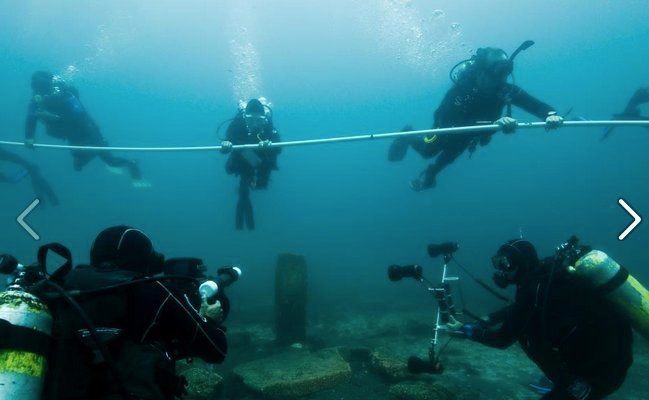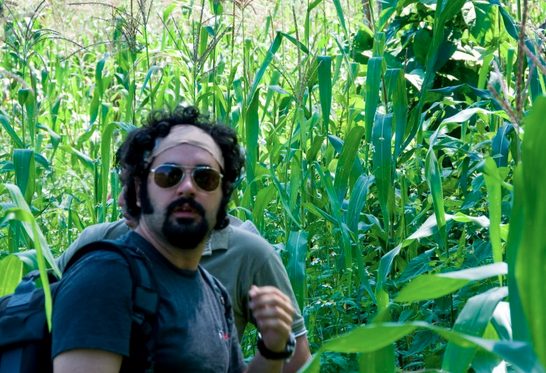
Rafael Garcia began his film-making career after graduating from the Savannah College of Art and Design and working in the Atlanta area on various projects. In 2006, he joined a start-up production company that took him on diving and fishing related programs throughout Central America. During this time, Garcia met several highly qualified divers and began to organize a dive team. Mayan Blue, a feature length documentary film, explores the history of the Yucatan and surrounding regions -- often underwater in cenotes, lakes and other unique water features of the region. Mayan Blue also reveals the remarkable archaeological site of Samabaj, a pre-classic site that was flooded in a cataclysmic event on Lake Atitlan some 2000 years ago.
JOSHUA BERMAN: When did you first travel to a Mundo Maya country and how did it impact you? How did you stumble on this story of a lost underwater city?
RAFAEL GARCIA: I first traveled to Mexico in November of 2007, having just established a small but elite team of divers and securing some funding to test our underwater camera gear. As a boy, and son to a history-obsessed father, I had long developed a fascination with the Maya civilization. I remember walking up to el Castillo in Chichen-Itza actually shaking with excitement. I am extremely grateful for all my experiences on this film, and it has truly been a dream come true. Now, having come out the other end and looking back on my experiences, I feel that I gained an appreciation, not just for the past accomplishments of the Maya people, but for a thriving, vibrant people still weaving a beautiful tapestry of culture.
We had originally begun filming throughout Mexico and Central America with the idea of creating a type of diving documentary or television pilot. We began hearing rumors almost immediately of ruins and artifacts around Lake Atitlan, and soon tales of lost cities and a 'Mayan Atlantis' began to reach us.
While relaxing after a day of diving at 'The Iguana Perdida', our dive HQ, the owner Deedle Ratcliffe pulled out a binder full of old magazine clippings featuring the lake. She drew our attention to an 'Advanced Diver Magazine' article highlighting one group of dive 'explorers' who had emerged from the lake with bags full of artifacts and pottery. The conversation soon turned to a local man who claimed to have discovered a set of ruins under the waters of the lake. In the mid 1990s, Roberto Samayoa registered what he called 'an underwater city' with the Guatemalan Ministry of Culture. His claims were shrouded in doubt. We would eventually meet with Roberto, dive on site and see first-hand that his claims were legitimate. Through the course of our relationship, the full scope of Roberto's discovery would be revealed and become the focus of the film.
JB: What is significant about Samabaj?
RG: There are a number of reasons why this discovery can be considered significant. From an archeological perspective, this is a wholly unique site, in that it is an island site and island sites in the Maya world are extremely rare. Furthermore, underwater Maya sites are largely unknown. A few sites exist in Belize along the coast, but underwater sites of this scale are unheard of in the area. It is immediately clear from the archeological evidence that the island was a ceremonial center, with large collections of stelea and a ceremonial plaza aligned to Atitlan Volcano. Classic Maya mythology describes the creation of the world as having occurred at the 'Three Stone place', a metaphor that mirrors the three volcanoes around Lake Atitlan perfectly. Lake Atitlan has long been considered a spiritual center in the Mayan world, and the lake is often referenced as 'el umbligo del mundo' or the axix mundi, the very spot from which the earth emerges.
In antiquity, the lake would have been a trade hub, a vital link in a network of Pre-Classic settlements and cities. Head archeologist of the Samabaj project, Sonia Medrano, postulates that faced with the flood event that engulfed the sacred site of Samabaj, a legend would emerge and spread throughout the Maya world, becoming the creation story of Classic era mythology with Samabaj as the literal Xibalba or underworld.
JB: You got to dive in Lake Atitlan, swim through caves, and fly in helicopters over Guatemala -- what was the most awesome travel moment you had during production of Mayan Blue? RG: Several moments stand out from my experiences on Mayan Blue. Certainly diving in the cenotes of Yucatan is amazing. The water is unbelievably clear and gives you the impression of soaring through these caves. It's as close as I'll probably ever get to being in outer space. As a fan of all things Maya since childhood, the most rewarding experience was seeing firsthand these amazing places.
RG: Several moments stand out from my experiences on Mayan Blue. Certainly diving in the cenotes of Yucatan is amazing. The water is unbelievably clear and gives you the impression of soaring through these caves. It's as close as I'll probably ever get to being in outer space. As a fan of all things Maya since childhood, the most rewarding experience was seeing firsthand these amazing places.
I have fond memories of standing on Temple IV at Tikal, overwhelmed with the sound of howler monkeys at sunrise and watching the fog trail through the jungle. I had the opportunity to enter the crypt within the temple of inscriptions at Palenque. Standing in the presence of the great Maya Lord Pakal is not something you get to do everyday; it is seared into my memory, a mental tattoo. Certainly we had some difficult moments too. Driving in Central America is always an adventure, and seeing the poverty that is rampant throughout the region is hard. But these things are part of what makes the Mundo Maya alluring.
JB: What advice do you have for someone traveling to a Maya village or archeological site for the first time?
RG: Be aware that you are being watched, carefully. There are too many stories of some tourist snapping a picture of a photogenic child and paying dearly for it in violence. Ask to take photos of people, and be prepared to pay. Don't be afraid to try something new as far as food, the Mayan world has much to offer in this regard, however, be aware of water sanitation concerns. Read and prepare. At an archeological site, read the plaques, inform yourself. You can avoid a lot of scam artists simply by being well read and prepared ahead of time.
JB: Did you stumble upon any specific places or programs, especially community-based tourism efforts, i.e. ground-up tourism ventures that empower Maya villagers?
RG: One of the richest and most visible signs of indigenous Maya culture around Lake Atitlan are the patterned Maya textiles and weaves. We were fortunate to be allowed access to the Cooperative of Women Weavers of San Juan La Laguna in order to film the traditional styles of textile weaving. The cooperative of 22 women are dedicated to preserving their ancestral methods of spinning, and are among the only people in the region who still spin their own thread directly from homegrown cotton. All of their dyes are natural and made from indigenous plants. Proceeds of their sales go directly to various Maya communities. The Cooperative has created scholarships for children, established a nutrition program and a women's health program.
# # #
Joshua Berman is the author of MOON MAYA 2012: A GUIDE TO CELEBRATIONS IN MEXICO, GUATEMALA, BELIZE & HONDURAS. This article originally appeared on The Tranquilo Traveler.